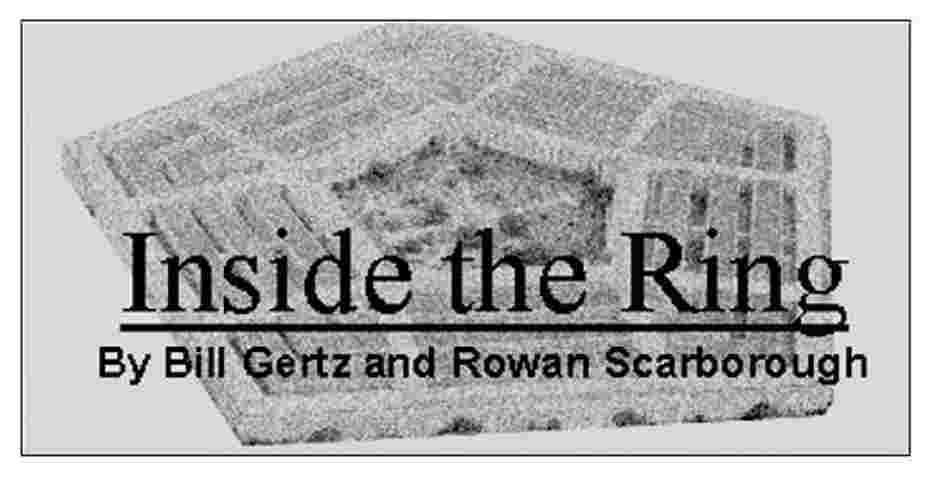|
Return to
|

|
December 17, 2004
Notes from the Pentagon
Fallujah findings
•Marines followed tanks of the 1st Cavalry Division into the city. Marines who stayed behind the tanks fared much better than those who had no tank escort.
"A lot of the insurgents saw the armored vehicles and hid," the soldier said. "They waited for the Marines to come and took their chances by fighting them, since the Marines weren't protected by armor like we were. In that first day of fighting, the Marines took five times the KIA and way more wounded, but they also did their job very well."
•The Air Force spotted and its aircraft bombed cars thought to hold improvised explosive devices (IED) that would be set off once Americans approached.
•Soldiers found "unbelievable amounts of drugs" in some terrorist safe houses, including heroin, amphetamines and cocaine. "It turns out the enemy drugged themselves up to give them the courage and stupidity to stay and fight," the soldier said.
The soldier concluded: "These insurgents are some sick people, and Fallujah proved that more than ever. Two mosques were not being used for prayer, but rather for roadside-bomb-making. They were literally IED assembly line factories with hundreds of IEDs complete or being built."
Satellite tasking
In fact, worries over the tasking of spy satellites are what spurred House Armed Services Committee Chairman Duncan Hunter, California Republican, to block legislation until he got language in the bill guaranteeing the NID would not interfere in the military chain of command.
We thought it would be useful to look at past practices for a clue into how the new relationship will emerge between the NID and the defense secretary.
Today, the CIA director controls satellite placement, even though the agencies that buy and operate them are located within the Defense Department.
The CIA, defense secretary and their staffs talk frequently about how to task these so-called national assets, whether it be to watch drug cartels in South America or insurgents in Iraq.
While the CIA chief has final say, the National Security Act stipulates that if there is any disagreement with the defense secretary, the president may step in. Thus, in actual practice, the defense chief has wide authority, since the president is always standing by to side with the Pentagon, if need be.
And there's the important point. In the history of the act, the president has never had to break a tie, so to speak, because the CIA and Pentagon were always able to reach an agreement, according to a congressional staff report we obtained.
"The DCI gave the DoD's collection requirement the highest priority during each of these conflicts, no transfer of authority was necessary," the paper says.
To adjust the intelligence community to the war on terror, President Bush further outlined the CIA director-defense secretary relationship in an executive order in August, amending order No. 12333.
Mr. Bush ordered the director to "establish collection requirements for the intelligence community, determine collection priorities, manage collection tasking and resolve conflicts in the tasking of national collection assets."
Fear factor
The plan, simply stated, is to break up each division into smaller brigades that are fitted with, and train with, support units. This way, brigades specifically tailored for certain missions can deploy more quickly.
Some officers complain privately that the new units lack sufficient firepower. But no one dares challenge the chief at one of his many chief-to-soldiers briefings for fear of reprisal.
Chinese arms show
One of the new weapons Mr. Fisher spotted at the Chinese show is a long-range strike bomber.
Another surprise at Zhuhai was China's new short-range ballistic missile, called the B-611. The missile is believed to be a derivative of the DF-15 short-range missile, which is deployed in large numbers near Taiwan. The Chinese showed the missile on a twin-missile truck launcher.
"Six of these could be connected to a separate command truck for a notional battalion," Mr. Fisher stated in a report. "With a lighter warhead, this missile might be able to increase its range in order to reach Taiwan. However, it is more likely the B-611 would be used to rapidly build up missiles on Taiwan that could be used to attack any U.S. forces coming to the rescue."
Three other advanced tactical missiles also were on display, including optically guided and microwave radar-guided missiles that were co-produced with Iran. The missiles have a range of up to 22 miles.
The Xian Aircraft Co. introduced a new cruise missile at the show that is about the size of the C-601 but with a V-tail. The Xian factory also is producing the older H-6 bomber, a Chinese copy of the 1950s era Soviet Tu-16.
|
|
Inside the Ring Archives
1999 Columns 2000 Columns 2001 Columns 2002 Columns 2003 Columns 2004 Columns |